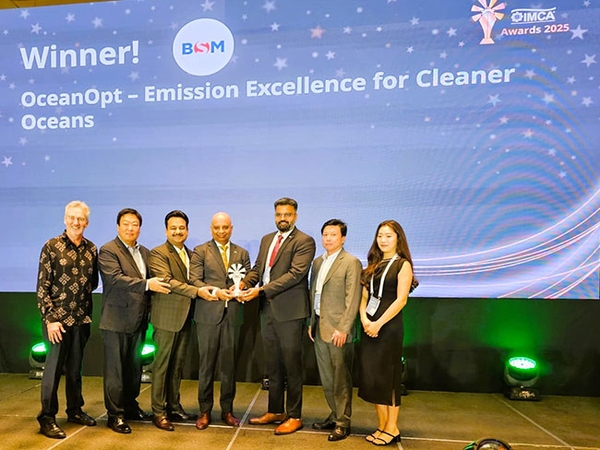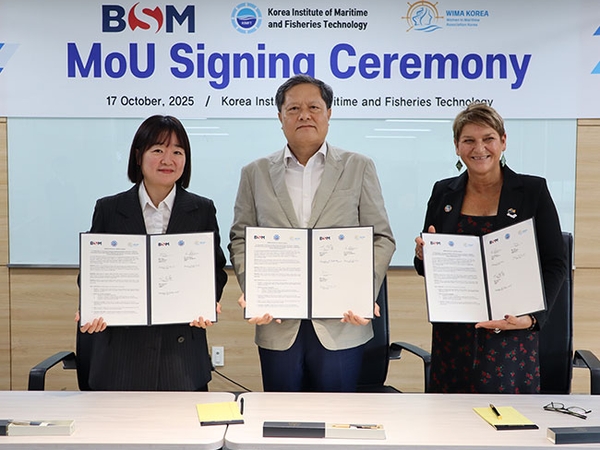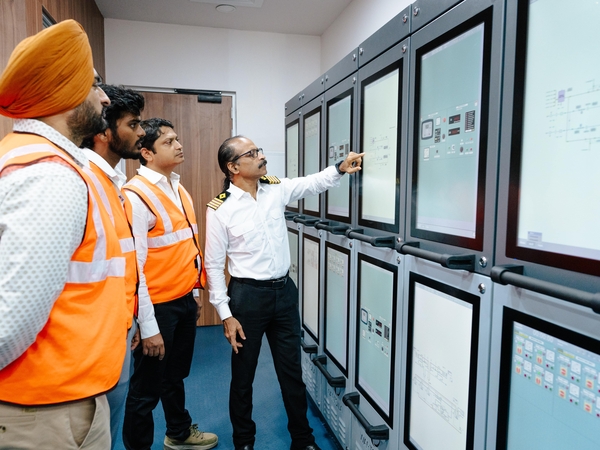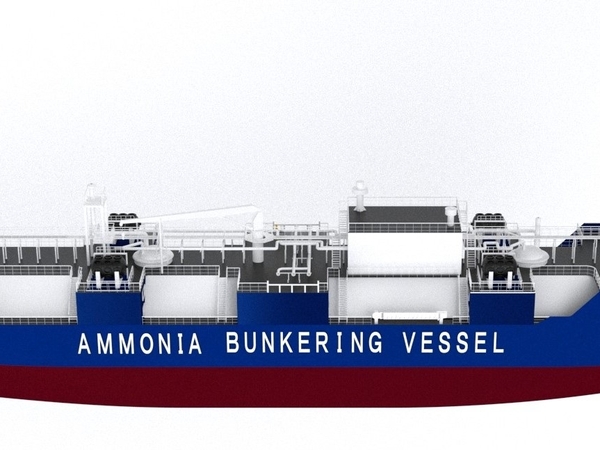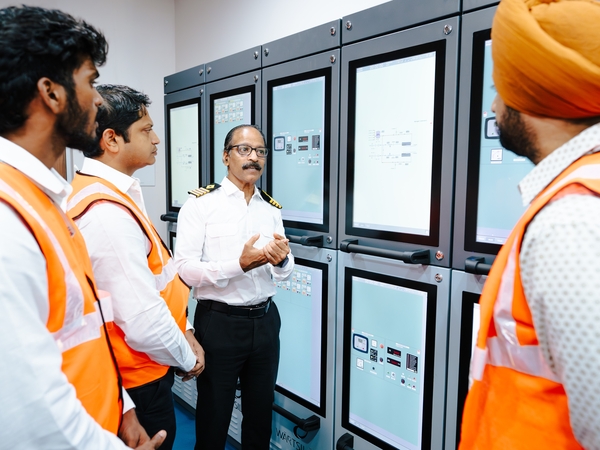
Schulte Group presented today for the first time its next generation design for an LNG bunker vessel (LBV) at Gastech Exhibition and Conference in Milan. The shipping group has used its experience as an LNG bunker vessel owner and operator to develop a new innovative LBV design that is easy-to-use, fulfils present and known future requirements for at-sea LNG bunker deliveries and reduces last-mile costs.
The unique vessel design does away with the need for fenders and spacer pontoons, which take time and manpower to manually deploy, replacing them with an integrated outrigging system that’s compatible with any vessel type and can be operational in five minutes with the push of a button. Same applies to the telescopic crane, which extends over 40 meters over the water and can be adjusted to any required reach. The vessel fits with all known and soon-to-come LNG-fuelled vessels.
It also features warming-up, gas freeing and aeration equipment to prepare LNG-fuelled vessels for drydock, and flexible design options so that the LBV can be tailored to specific requirements. The bunker vessel can be operated by a smaller crew whilst still ensuring high safety standards.
All of these components are geared towards reducing the CAPEX (capital) and OPEX (operating) costs for owners and operators, and ultimately will achieve low last-mile costs for the LNG-fuel industry, including the LNG-fuelled client vessels.
Johan Lillieskold, Gas Solutions Specialist, LNG Competence Centre, at Schulte Group said during his conference presentation at Gastech, “We examined the market’s current requirements and recognised the need for a straightforward LNG fuel vessel that reduces the cost of last-mile delivery for vessel operators. We have gone back to the drawing board and defined the operational specifications of what the ideal LNG bunker vessel should offer, doing away with any additional or unnecessary gear and cumbersome operations.”
The LBV has been designed to maximise operational compatibility, including: vessels with protruding structures from the hull, such as those typically found on cruise liners with protruding lifeboats, deck structure and balconies; vessels with short bodies such as high-speed, slender container vessels; those with high freeboards including large crude oil and bulk carriers.
LNG is an increasingly popular choice of fuel as owners and operators seek to reduce emissions from their ships’ operations. Some of LNG bunkers are currently delivered from shore-based trucks to ships berthed alongside, and whilst these activities will still be available going forward, LNG sea-based deliveries will eventually dominate supply to merchant and cruise LNG-fuelled vessels.
Lillieskold said, “The number of LNG-fuelled vessels planned to enter into operation in the next few years is significant as operators increasingly turn to LNG to reduce environmentally and climate harmful emissions. The current arrangements for LNG bunkers, both land based and sea based, will not be sufficient or suitable for the increasing volume of LNG-fuelled tonnage planned for future years. This new flexible vessel design will serve both today’s tonnage and future newbuilds.”
Schulte Group’s LBV has been developed in accordance with the International Code for Safety for Ships Using Gases or other Low-Flashpoint Fuels (IGC) Code and other IMO regulations. It also complies with and is prepared for new and future decarbonising rules and regulations like IMO’s Carbon Intensity Index (CII) and EU’s Fit-For-55 programmes.
In this context, measures are either built into the design or available for future upgrade with, for example, a battery hybrid solution or retrofitted for hydrogen power. In combination with a battery hybrid solution and “green” shore power, depending on the operation profile, the vessel could operate largely carbon-emissions free.
Overall, the next generation LBV design brings together safety, compatibility, eco sustainability, operational flexibility and cost efficiency.
RELATED Articles
The Schulte Group mourns Dr Heinrich Schulte
18 Dec 2025 - Press Releases
The Schulte Group mourns Dr Heinrich Schulte
BSM wins IMCA Greenhouse Gas Project of the Year
05 Dec 2025 - News
BSM wins IMCA Greenhouse Gas Project of the Year
BSM, in partnership with Schulte Group member OceanOpt, has won the Greenhouse Gas Project of the Year at the IMCA Annual Awards 2025. The ceremony was held during the Global Summit in Kuala Lumpur on 26 November.
BSM Smart Academy expanding Global Partnerships
05 Dec 2025 - News | Articles | Articles
BSM Smart Academy expanding Global Partnerships
BSM partners with Seven Clean Seas to remove 25,000 kg of ocean plastic each year
19 Nov 2025 - News | Articles | Articles
BSM partners with Seven Clean Seas to remove 25,000 kg of ocean plastic each year
BSM Training Foundation Achieves A1 Grading Under DG Shipping’s Comprehensive Inspection Program
17 Nov 2025 - News | Articles | Articles
BSM Training Foundation Achieves A1 Grading Under DG Shipping’s Comprehensive Inspection Program
BSM pioneering in Alternative Fuels Training with successful launch of Methanol Training Courses
27 Oct 2025 - News | Articles | Articles
BSM pioneering in Alternative Fuels Training with successful launch of Methanol Training Courses
As the maritime industry accelerates its transition toward sustainable energy solutions, Bernhard Schulte Shipmanagement (BSM) is proud to announce a significant milestone in crew training and safety innovation: the successful launch of bespoke Methanol as Fuel Courses, including the specialised Methanol Firefighting Course, across its global Maritime Training Centres (MTCs).
BSM to manage world's first ammonia bunkering vessel
30 Sep 2025 - News | Articles | Articles
BSM to manage world's first ammonia bunkering vessel
Pronav welcomes first FSRU to its managed LNG fleet
18 Sep 2025 - Press Releases
Pronav welcomes first FSRU to its managed LNG fleet
Schulte Group x Treedom: Growing a Greener Future Together
01 Sep 2025 - News
Schulte Group x Treedom: Growing a Greener Future Together
We are thrilled to announce the renewal of our partnership with Treedom, a global NGO dedicated to reforestation and community empowerment. Together, until the end of 2024, we have planted 5,100 trees across 5 countries, absorbing 2,443 tonnes of CO₂, a major step toward a more sustainable planet!
BSM to launch its first methanol bunkering simulator to prepare seafarers for a low-carbon future
31 Jul 2025 - Press Releases
BSM to launch its first methanol bunkering simulator to prepare seafarers for a low-carbon future
BSM hosts transformative maritime summit as the company inaugurates its new training centre
03 Jul 2025 - News | Articles | Articles
BSM hosts transformative maritime summit as the company inaugurates its new training centre
Pioneering LCO2 tanker finally in its proper element
02 Jul 2025 - News | Articles | Articles
Pioneering LCO2 tanker finally in its proper element
BSM Hellas Celebrates 20 Years of Maritime Excellence
17 Jun 2025 - News | Articles | Articles
BSM Hellas Celebrates 20 Years of Maritime Excellence
The BSM Hellas Ship Management Centre (SMC) in Greece, proudly marks its 20th anniversary this year.
BSM at IMCA DP Conference 2025
10 Jun 2025 - News | Articles | Articles
BSM at IMCA DP Conference 2025
Bernhard Schulte Shipmanagement (BSM) proudly participated in the IMCA Dynamic Positioning Conference 2025, held on 3–4 June in Istanbul, Turkey. This premier global event brought together over 120 professionals from the offshore and maritime sectors, including experts in offshore wind, oil and gas, marine engineering, and vessel design.
Adventure Race Japan: a great fundraising effort for seafarers worldwide
27 May 2025 - News | Articles | Articles

